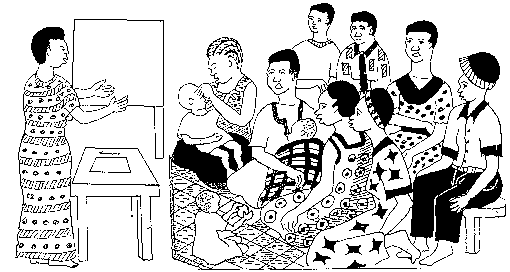Tweet
Translations:
'العربية / al-ʿarabīyah
Bahasa Indonesia
Български език
Català
中文 / Zhōngwén
Deutsch
English
Español
Euskara
Ewe
Filipino/Tagalog
Français
Galego
Ελληνικά / Elliniká
हिन्दी / hindī
Italiano
日本語 / Nihongo
Kiswahili
한국어 / Hangugeo
بهاس ملايو / Bahasa Melayu
Português
Română
Русский
Српски / Srpski
>తెలుగు /Telugu
ไทย / Thai
Türkçe
اردو / Urdu
Other formats:
Other Pages:
Modules
Site Map
Key Words
Contact
Utility Documents
Useful Links
ORGANIZING FOR STRENGTH
Increasing Capacity by Organizing
by Phil Bartle, PhD
Training Handout
Other factors being the same, level of organization determines strength
While there are many factors that contribute to strength, capacity, or empowerment, the one that most concerns a mobilizer is "organization."
Other factors being equal, the level and effectiveness of organization determines the strength of a group, agency or community.
Let us use a foot ball team as an example. If you have two football teams, with the same number of individuals, the same range of skills, physical condition, and technology (eg quality of shoes), they would be equal.Let us say one team is not organized; there is no division of labour, no co-ordination, no recognizable social structure. The other team is organized, has a coach with authority, has different roles for goalie, defence, left and right wings, centre forward, and other division of labour.
Other factors being the same, level of organization determines strength. Different team members have different roles and practice playing in an integrated manner (eg passing the football). In this case it is easy to see that the second team is more powerful, has more strength and capacity than the first one, even though their other characteristics are equal.
Better organization makes better capacity. So, too, with whole societies.
Take this example (not for the history it contains, but for the sociological principle). The Akan of West Africa expanded rapidly during the sixteenth and seventeenth centuries, and rapidly conquered the Guans who preceded them.The level of technology (including weapons) was about the same, as were most other characteristics.
But the Guan were patrilineal and lived in dispersed lineages, while the Akan were matrilineal in a way that organized the different clans into functional alliances, lived in nucleated settlements, each clan having a different role in warfare (forward, left, right, rear, domestic, and paramount) and a state organization.
Like in the organizing of a football team, other factors being equal (technology, skills), the more organized system (Akan, the epitome of whom were the Ashanti) conquered the less organized.
The point, for you as a mobilizer, is that your goal in strengthening a low income community, is to help your target group consciously organize for more effectiveness.
You do not form a CBO executive for its own sake, or help them choose chair, vice, secretary, and treasurer, just to have pretty titles. You help them get organized, get better organized, or reorganized for effective action, to empower them. Better organization results in better power.
Other modules will guide you in organizing. Be conscious of why you organize (to what end?) and let your target group participate as partners in this noble endeavour (the empowerment of low income communities).
––»«––
Community Organizing
 |